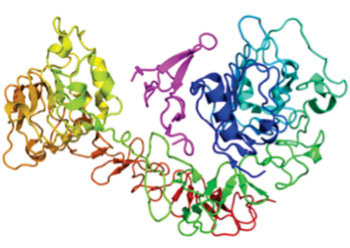Epidermal Growth Factor Receptor Stimulates Early Cancer Metastasis
By LabMedica International staff writers
Posted on 16 Nov 2015
The stimulation of blood vessel formation by epidermal growth factor receptor (EGFR) early in tumor development was found to facilitate metastasis of the original tumor even before it was diagnosed.Posted on 16 Nov 2015
Mutations that lead to EGFR overexpression have been associated with a number of cancers, including lung cancer, anal cancers, and the brain cancer glioblastoma multiforme. Somatic mutations involving EGFR lead to its constant activation, which produces uncontrolled cell division.

Image: Diagram of the epidermal growth factor receptor (EGFR) (rainbow colored, N-terminus = blue, C-terminus = red) complexed to its ligand epidermal growth factor (magenta) (Photo courtesy of Wikimedia Commons).
Many malignant characteristics of cancer cells are regulated through pathways induced by the tyrosine kinase activity of EGFR. Investigators at the Scripps Research Institute (La Jolla, CA, USA) reported in a study that was published in the August 2015 issue of the journal Neoplasia that besides directly affecting the biology of cancer cells, EGFR also regulated the primary tumor microenvironment. Specifically, their findings demonstrated that both the expression and signaling activity of EGFR were required for the induction of a distinct intratumoral vasculature capable of sustaining tumor cell intravasation, an early step of metastatic dissemination during which tumor cells enter angiogenic blood vessels, which is a critical rate-limiting step in the metastatic cascade.
The investigators stated that this study unraveled an important but overlooked function of EGFR in cancer, namely, its ability to create an intravasation-sustaining microenvironment within the developing primary tumor by orchestrating several interrelated processes required for the initial steps of cancer metastasis through vascular routes. Their findings also suggested that EGFR-targeted therapies might be more effective when implemented in cancer patients with early-staged primary tumors containing a VEGF (vascular endothelial growth factor)-dependent angiogenic vasculature.
In experiments using chick embryos, the investigators found that EGFR signaling triggered a chain reaction inside tumor cells, ultimately resulting in the release of VEGF, known to be active in almost all forms of solid tumors. Released VEGF then bound to endothelial cells, inducing the growth of new blood capillaries and vessels within a developing tumor.
"When cancer cells have high levels of EGFR, the tumor has a lot of new, angiogenic blood vessels," said senior author Dr. Elena Deryugina assistant professor of cell and molecular biology at the Scripps Research Institute. "And these vessels are very welcoming for tumor cells and facilitate their dissemination from the very early stages of tumor development. Now we have learned that these newly formed vessels are used by tumor cells for dissemination because of their certain structural properties."
Related Links:
Scripps Research Institute










 (3) (1).png)


